|
|
|||||
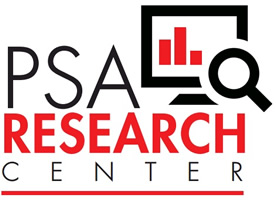 |
|||||
Myths
and Frequently Asked Questions
|
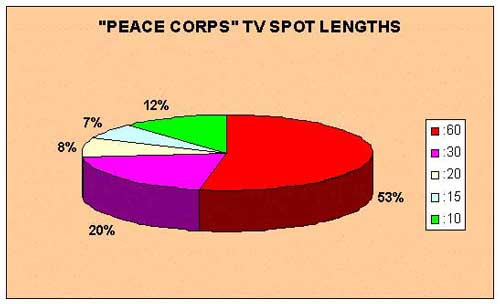
|
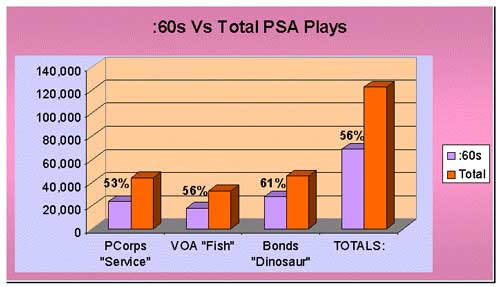
|
The article entitled: How You Can Use Evaluation Data to Fine-Tune Your PSA Program expands on TV PSA spot lengths usage.
Essentially the same rules that apply to other media apply to radio, i.e. offer spot length flexibility for best results. Also it is important to offer radio stations live announcer scripts, as well as recorded spots. Many radio stations in the larger markets will not use pre-recorded PSAs because they want to have their on-air personalities read public interest messages live. This approach helps build a stronger brand image of the station in today's highly competitive radio industry.
In terms of print, smaller is better than larger PSAs, and you should offer a good mix of sizes in both horizontal and vertical formats. Click on the following link for more specifics: www.goodwillcommunications.com/gc_support_client_corner-frameset.asp?page=gc_support_client_corner-printpsas.asp
Q: Are more stations moving to digital tape formats instead of analog?A: We track the preferred video tape format for every station in the U.S. and what we are seeing is a gradual shift to more digital formats, including DVDs. It is important to provide your distributor with the best quality master, which is the Apple Pro Res format, thus any tapes replicated from the higher quality master have better quality. The graph below shows the current dub format breakdown for all broadcast and cable TV stations in our master database at the end of 2013.
Q:What is the status of downloading digital files for TV stations?
A: In a survey conducted among TV Public Service Directors from 100 stations in 39 states and the District of Columbia, 42% said they occasionally download them; 37% said never; 20% reported frequently and 1% answered that they only download PSAs. Of those respondents answering “Never “ or “Occasionally,” the reasons given included time requirements (41%), lack of technology (26%), virus concerns (3%), and station receives many hard copies making downloading unnecessary (55%).
Q: How many different PSAs should we send to the media at the same time?
A: This question is related to the one above but approaches it from a different angle. While it typically doesn't cost much more to send a large number of PSAs in the same package, the real question is will the media use them? Unquestionably, at some point, a large number of PSAs will compete against themselves for valuable airtime so it is wise to have a well conceived plan for distributing your messages. For TV, probably anything above six spots even in different lengths on different topics is the maximum you can expect to get used.
For radio, it is more complicated due to program formats and and the amount of time stations have available. However, given all the PSAs stations receive, they would rather have a good diversity of spot topics from various non-profits than a bunch from a single source on essentially the same issue.
That being the case, anything above eight would be considered excess and ideally those eight spots should be in various lengths or in different program formats, i.e. musical beds with C&W music, classical, Spanish, urban, etc. The reason for the latter is that a station might use something that has been produced to fit with its musical format, whereas it would otherwise not use the extra spots.
A very important thing to consider is producing messages that permit the stations to sell airtime around your message. For IRS, we produced radio "donuts" that give stations the opportunity to sell airtime to local sponsors. The chance that these types of messages will get aired is much greater because they bring revenue into the station.
If you already have a large number of PSAs on hand, consider distributing them in waves, rather than all at once and we believe you will be very pleased with the results from that decision as compared to sending them out all at once.
Q: What is the capacity of a CD - how much content can we include for PSAs releases- and what is the best file format for sending PSAs to radio stations?
A:View the article that addresses this question at: /www.goodwillcommunications.com/PSACampaignPreparation.aspx.
Q: Why should we retain the services of an external distributor; wouldn't it be much cheaper to buy media lists and distribute the PSAs ourselves?
A: As with many things in life, you get what you pay for. In a few cases of which we are aware such as the Partnership for a Drug-Free America, PSAs can be distributed successfully using internal resources, but they have spent years developing local coalitions which help them get PSAs to stations.
There are
a variety of things to consider in PSA distribution above and beyond just
having a media list. For example, TV stations now prefer getting PSAs
in a variety of different dub formats (we distribute PSAs in six different
tape formats) and if you don't send stations what they want, your chances
of getting airtime are slim. In a universe of at least 40,000 mass media
outlets, you also must know which media outlets do and do not use PSAs
to maximize your resources.
Next, you need to know who the decision-maker is at all the media outlets
you are targeting - typically over 10,000 individuals if you are doing a multi-media
campaign. You have to have a list of all the national networks, which can generate up to
two-thirds of all your PSA usage and the formats each requires. Finally, there are complex evaluation procedures
that require sophisticated reporting software to provide meaningful results. A professional
distribution service offers these services, and can handle all the other
details associated with getting a campaign out to the right person at
the right time and in the right format saving valuable internal resources.
If you were to factor all your costs – including staff time - to
do the job internally and weigh that against what you get in media exposure,
professionally distributed campaigns are probably a better value.
Finally, a good distributor will help guide you through the entire process
of PSA campaign development, from positioning to placement, and that should
be a valuable consideration. Q: We
have a PSA that has been distributed previously, but is still very relevant.
Is it possible to “recycle” it to save production costs and
will it get used? A:
Sending PSAs to stations a second time - if properly executed - can actually
generate more exposure the second time around. Some of our military clients
have re-distributed TV PSAs two and even three times (see article by clicking
on the link below.) Keep in mind that there is a tremendous turnover in
community affairs personnel at most broadcast stations and they often
don’t have a good logging system to tell them what has been aired
previously. If you decide
to re-distribute your PSA, there are two things you should consider:
- You need to ensure that your talent and music payments will cover the re-release
- You should change the external packaging to give it a fresh look, at least changing the colors of the packaging collateral
For more information, including a graph showing results of campaigns that have been re-released, click on: Recycling TV PSAs - How to Stretch Scarce Production Budgets.
Q: How
do you build a distribution list? A: There
are several factors we consider when building a distribution list and
this generally applies to all media. First, you should know the previous
usage practices of the media outlets in your distribution plan.
The highest priority are those that have used a particular client’s
PSAs previously, then we look at something called the Previous Usage Index
(PUI) for the media outlet – the number of times they have used all
our clients’ PSAs. For radio,
we look at the PUI as well as the program format for the station and attempt
to match the station’s radio program format with the client’s
primary audience. Also, with radio there many stations which simulcast
programming – broadcasting the same basis programs on their AM and
FM stations. To avoid duplication and save money, we send PSAs to
only the FM station because it typically has a stronger signal. For print
media, we build custom magazine mailing lists with publications that reach
the client’s target audience and for newspapers, we use the PUI,
the type of newspaper - dailies vs weeklies - and circulation size to
build our distribution lists. As for out-of-home media,
we can target PSA poster placements in a different ways - by media venue, i.e. airports
vs shopping centers or by geography, selecting cities, states or regions. For print
media, we build custom magazine mailing lists with publications that reach
the client’s target audience and for newspapers, we use the PUI,
the type of newspaper - dailies vs weeklies - and circulation size to
build our distribution lists. Q: Is
it better to distribute more than one PSA on the same tape? A: It depends
upon what you are trying to accomplish and your budget. If the choice
is between sending two different PSAs in the same length, versus sending
the same PSA in different lengths, we would usually recommend the latter.
Giving stations as much flexibility as possible on spot lengths is critical
to getting your message on the air because of the random nature of unsold
air time. If you have the spot length that matches the “avail,”
you stand a much greater chance of getting something aired. However,
there are no absolutes in the PSA distribution business. For example,
if you have two spots - one with a mainstream message, and the other more
controversial, you may want to include both in the same package to give
stations options. Obviously it is better that you get something on the
air than nothing. However, in many cases, by offering too many options,
you will be competing against yourself. We believe
you would get a lot more mileage out of the PSAs by releasing them in
two waves, versus distributing them all at the same time. There is only
so much time available, and most public service directors are not going
to use all the PSAs you send them just because they happen to be on the
same tape. But here again, other circumstances need to be considered such
as budget. If you can only afford to send out one campaign, and you have
a number of different PSAs in your library that are current, you may want
to send them to give stations flexibility in subject matter and spot length.
You do need
to know, however, that putting more than five or six PSAs on a videotape
will increase your cost without question because you must use a much longer
video tape than normal (five minutes is the cost break). Also, it may
cost more to track via A.C. Nielsen (ten is the maximum number of spots
for the basic fee), and you may have to do a different type of storyboard
than is typical to accommodate the different spots. There is
very little data to support the "more versus less" distribution
strategy. For one client that distributed ten different PSAs in the same
package (most were the same spot length) they generated no more exposure
than a typical PSA package with only four spots in it (same spot, different
lengths). Obviously other factors such as message content, production
values, local impact, etc. have some bearing on the results, but generally
less is more in this context IF you provide maximum flexibility on spot
lengths and print ad sizes. Q: With
today's satellite technology, why shouldn't PSAs be distributed via satellite,
rather than going to the expense and time to replicate and distribute
PSAs via tape and CD? A: Satellite
distribution works very effectively with Video News Releases (VNRs), and
ANRs (Audio News Releases), or anything directed to the news side
of the broadcast station. However, PSAs are not directed to broadcast
news departments; they are sent to public service or community affairs
directors who are not used to getting PSAs via satellite. They presently
get all the PSAs they could ever hope to use, dropped conveniently on
their desk without worrying about satellite coordinates or interfacing
with the news department. Accordingly, adding anything that requires work
by the public service director is one more reason for them not to use
your PSA. In a test
for the National Eye Institute, a PSA was distributed via both hard copy
and satellite, and then tracked separately by SIGMA. Feedback on satellite
usage included a half dozen stations, all of them in smaller markets,
versus usage on 91 stations which aired the hard copy version 2,606 times
including many large market stations. This test indicated hard copies
were used on significantly more stations, than usage generated by satellite
transmission. Q: What's
the relationship between the networks and their affiliates - if we get
the networks to use our PSAs, does it mean they will run nationally?
A: While
you should attempt to get the "big for" (ABC, CBS, NBC and Fox) to accept your
PSAs, it doesn't mean they are going to air them on national television.
The networks feed PSAs to their affiliates in what is called an “uncovered
position,” meaning they can be pre-empted by local affiliates in
favor of a locally paid spot, a locally-produced PSA, or even one that
is distributed to them by a national distributor. In these situations,
they have no obligation to use PSAs fed to them by their parent network.
For this reason, it is very important that you also distribute a hard
copy videotape with your PSA to the network affiliates which greatly increases
your chance of getting something on the air. For more information about
this subject, see the article entitled: Network Clearance
- A Producer's Checklist. Q: What
is the best way to package PSAs to maximize usage? A: Depending
upon your budget, you can spend more than $10 each for just the TV package
in which your PSAs are sent to stations, but we do not believe overly
elaborate packages increase usage, and in fact, can actually have a negative
impact on how they are viewed by gatekeepers. Keep in mind, by definition,
you must work for a non-profit or governmental agency to qualify for PSA
airtime and space. If you produce very expensive packages, the media
may wonder if you are using your organization’s resources judiciously.
For our clients,
we use the very lowest cost, highest impact packages we can produce with
the goal of using our distribution budget to target the maximum number
of outlets. For samples of how we package client PSAs, go to www.goodwillcommunications.com/CSP_CC_ChecklistsTemplates.aspx.
Q: What
is the best way of packaging Spanish PSAs? Where possible,
you should include both English and Spanish PSAs all in the same video
or audio package, even though they will be used by completely different
types of stations. The same is true if you have a radio PSA aimed at discrete
audiences such as college students, African-Americans, etc. There are
some media outlets that will use both formats because they have both English
and English speaking audiences. Most importantly, by ganging the PSAs
together, it saves you a significant amount of money as compared to producing
a completely separate package. Obviously if you are releasing the two
different campaigns at different times this packaging procedure won't
apply. However, for the most part ganging both English and Spanish together
works well, because you take advantage of the fact that your costs are
covered via the English package, and there is up to five minutes of video
time and 80 minutes of capacity on a radio CD to work with. Also, keep in mind
that only the creative message itself needs to be in Spanish, as most people
working in American media outlets are bi-lingual. Q: To
whom should I send my PSAs? A: The key
contact is different depending on the medium. For television, there may
be several people who typically make the PSA decision, depending upon
the size of the station and their community affairs policy. It is either
the Public Service Director, the Director of Community Affairs, or the
Program Director. At smaller stations the General Manager may be the contact
person. The GM usually has a heavy influence on program policies, regardless
of size. At radio stations the decision-making is more diffused, and again,
it depends upon the size of the station. Larger stations will likely have
a Public Service Director, but at smaller stations the Program Director,
Station Manager, and perhaps even the Engineer or disk jockey could get
involved in putting your PSAs on the air. At print
outlets, and this is very important, don't send PSAs to
the editorial department. Remember, print media - like all others - is
split into two camps... business and editorial. PSAs - are advertisements
- even if they are being run pro-bono - and should be directed to the
Advertising Director, Publisher or Production Director for both
magazines and newspapers. Most importantly, to the extent possible, you
should send PSAs to a specific person, rather than to a generic title.
Being aware of all the little details can help you get your message on
the air, or in print, and the personal touch can make the difference in
getting your materials used or sent to the round file. And, speaking of
the personal touch, don't forget to say thank you to those media outlets
that use your PSAs. These dedicated professionals provide non-profits
with hundreds of millions of dollars worth of free time and space each
year. Don't you think that deserves a simple thanks? If you don't
think so, read the article by clicking on this link: "Hard Being Good - Worthy
Causes but Unworthy Ads". Q: What
are the best times to distribute a PSA? A: While
most any time of the year is appropriate given the long shelf life of
a typical PSA campaign, there are some times that are better than others
and it also differs by medium. For TV, there is generally more time available
in the first half of the year in terms of unsold inventory, particularly
the first quarter. However, that is also when more organizations distribute
PSAs, so things could be a little tight until new releases are absorbed
into the system.
For radio, the summer time is when there are more people
out of home and in their cars so that is a good time to distribute a campaign,
particularly if you are trying to reach young people. For all media, the
fourth quarter, particularly right after the Thanksgiving holiday is not
the best time to distribute PSAs, due to the heavy paid schedules prior
to Christmas. Perhaps the most optimum time is the week immediately after
Christmas because it is a very slow sales period among the media and you
can pre-empt other organizations that will be distributing their campaigns
at the first of the year. Also, it
is a good idea to tie the release of your campaign in with other promotional
activities and special community events such as the Race for the Cure,
the MS Walkathon or Earth Day. The media often focuses editorial attention
on these issues which can reinforce the impact of your PSAs. Q:
What is the best way to distribute outdoor PSAs? Due to the
high cost of producing outdoor billboard paper and other unique attributes,
outdoor needs to be handled very differently than other kinds of media.
Rather than spending a lot of money to produce sizes that may never be
used, our approach is to solicit the media on the types of sizes and quantities
they will use prior to producing the billboard paper and then fulfill
based on our solicitation requests. We have completed this type
of placement effort for a number of clients with considerable success.
For additional information on how we distribute outdoor, go to
www.goodwillcommunications.com/gc_support_client_corner-frameset.asp?page=gc_support_client_corner-outdoor.asp
Q: What
are "ISCI codes" and how do I get one for my next TV PSA release?
A: The ISCI
code system has been replaced by what is called Ad-ID, a Web-based
system that generates a unique identifying code for each advertising asset,
creating a capability to identify them across all media. Developed by the American
Association of Advertising Agencies (4A's) and
the Association of National Advertisers, (ANA), Ad-ID upgrades the previous
ISCI commercial coding system, "greatly improving workflow between agency,
advertiser, distributor and medium." There is no cost for a non-profit 501(c)(3)
organization. To download the appropriate forms, go to
http://www.www.ad-id.org/501c
.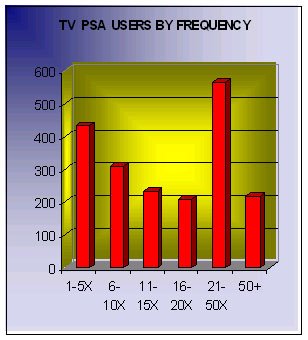
Q: What is the A.C. Nielsen SpotTrac monitoring system, how does it work and what is its scope of coverage?
A: When we receive a TV master from a client, the first thing we do is to encode the master with the Nielsen SpotTrack code that is invisible when the PSA is broadcast on the air. In order to place the SpotTrac encoding on the master for HD formats an HD SPOTTRAC encoder is required and most dub houses that handle PSAs have this equipment which must be approved by Nielsen.
One the code is embedded on the master, it is then replicated onto all tapes that are distributed to TV stations. Nielsen has monitoring equipment in all 212 DMAs around the country, and when the PSAs are aired, Nielsen's monitoring system is able to track exact time usage of the PSA. The data from that usage is then fed to our computer, we add value to their data and report value-added PSA usage reports to clients.
Q: Beyond the normal metrics of advertising equivalency, Gross Impressions, etc., how else can PSA values help a non-profit?
A: There is an important,
but widely unknown rule governing how "in-kind contributions"
are treated by non-profits, which includes PSA air time value. The technical
explanation was provided by a Certified Public Accountant with experience
in PSA valuations. You can read more about it at:
www.goodwillcommunications.com/Fund_Raising.aspx"
Q: Aren't
most PSAs broadcast in "junk time" from midnight to 6 AM when
no one is watching TV or listening to radio? A: Various
studies, particularly data from the Nielsen SpotTrac system show that in
one campaign after another, the majority (from 50-65%) of all PSAs air
in the more desirable dayparts - from 7 AM to 11:30 PM. A benchmark composite
showing usage from seven different PSA campaigns showed that on average,
56% of all PSAs aired in these dayparts. You may say that with so many
working women today, PSAs that air during the day don't reach enough people.
But if that is true, Proctor and Gamble should fire their advertising
agency because they sure buy a lot of paid spots during this time. Also,
if young people are your primary target, they like to stay up late and
watch music videos, movies and other programs that are broadcast in the
late evening. So again, late night is not necessarily bad time. The graphs
below show usage by daypart for two typical campaigns using Nielsen SpotTrac data.
If you think
all PSAs are used when no one is listening or watching, take some time
to browse the articles under PSA Bibliography - Campaign Effectiveness;
it may change your thinking. Q: I've
never seen our PSAs...do they really work and how do we know? A: The scholarly
literature on the subject is somewhat limited, but there certainly is
empirical evidence that PSAs are a cost-effective way to reach the public
about important issues and causes. Notice we didn't say anything about
changing behavior or attitudes which is a complicated undertaking and
a long-term objective. However, if delivering impressions to an audience,
getting people to phone, visit a website, or getting volunteers are your
goals, there is ample evidence that PSAs can meet these objectives. For
example, a campaign we launched for the USDA generated over 31,000 requests
for a packet on soil conservation. Over a seven year period our Peace
Corps PSA work generated 782,000 leads, resulting in 58,558 applications,
21,456 invitations to join, and 18,028 actual Volunteers. Another campaign
we launched for the National Institute on Aging generated over 40,000
requests for their exercise brochure uniquely promoted in their TV PSAs.
The research
data on PSA effectiveness includes two studies posted to our Research
Center. One compares the effectiveness of paid advertising vs PSAs, and
the other was conducted by the Advertising Research Foundation. For more
details, click on this link Campaign Effectiveness.
For broadcast
TV, which will generate the majority of PSA exposure, we use the A.C.
Nielsen’s “SpotTrac” monitoring service which tracks PSA usage
in all 212 U.S. TV markets. (See earlier question on how it works). Q: How
much dollar value can we expect to generate from our PSA campaign?
Obviously
there are many different factors that affect how much usage any given
PSA campaign will receive, including the relevancy of the issue, time
of year it is released, media awareness of your issue, how the PSA was
distributed, promotional activity, creative quality and which media you
use just to name a few. Assuming a multi-media approach and professional
distribution, the following benchmark data is taken from dozens of campaigns
we have distributed. On average
a broadcast TV PSA itself will generate exposure in 166 markets on 213
stations and 13,000 airplays for six months. If our cable distribution
service is included in the distribution plan, cable usage will add 11,000
more airplays on average to the total. For radio,
you can expect to have your PSAs used more than 50,000 times on nearly
600 stations, generating $732,000 in value (a reminder postcard will generate
about 10 percent additional value). Print PSAs will be used on average
by 1,299 publications (986 weeklies, 288 dailies and 25 magazines) generating
an average value of $325,000. Also, the
length of time you monitor your campaign can have a significant impact
on values. The number of broadcast TV airplays on average increases to
22,000 if you extend monitoring of your campaign for twelve months. The
following graph shows the results of tracking at different periods.
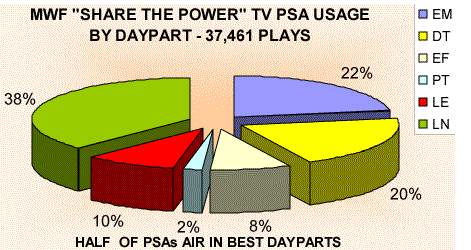
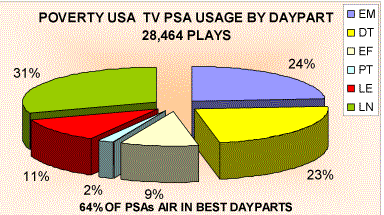
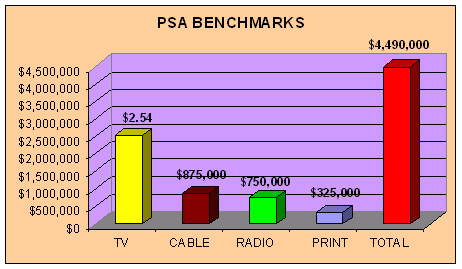
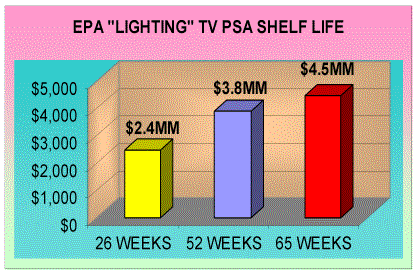
|
Q:
Are there other methods to tracking of radio PSAs other than just business
reply cards (BRCs)?
A: Yes there is a new electronic tracking procedure offered by Nielsen s being developed and
which tracks PSA usage on
2,200 radio stations in major markets. It uses passive monitoring technology,
meaning that there is no code that has to be embedded on the creative
master such as the case with the Nielsen TV tracking system. The schematic
below shows how the technology works and our software is programmed to
avoid redundant reporting between this data and that received via BRCs.
![]()
MISCELLANEOUS QUESTIONS
Q: What factors determine usage?
A: In various sections of our FAQs, we address this question, but to succinctly restate the factors that affect usage, they include:
-
Available inventory. In larger broadcast markets, there is less time available due to more paid sponsors and obviously there is more demand for the best dayparts such as prime time.
-
Creative quality – it has to be very good to get on the air.
-
The issue or focus of the PSA (health, safety, emergencies and environmental issues typically perform better than others.
The time of year they are distributed (fourth quarter is worst).
-
Flexibility in terms of spot length (more is better).
-
How well the campaign is packaged (avoid overly elaborate packages, but it must be compelling and intrusive).
-
The number of stations targeted and the quality of the distribution process – targeting the right person and sending the right formats to stations.
-
The number of TV networks you target and how you collaborate with them. We are presently distributing to 130 national networks and we call each of them to pitch our client PSAs. For one client network usage accounted for two-thirds of all exposure and for most PSA campaigns, network will generate at least a third to 50% of total exposure if you send them what they want and do follow-up calls.
-
Last, but definitely not least, is local impact as shown in this graph. The data was taken from a survey of 1,000 broadcast TV public service directors with a 72% response rate.
Q: About how many PSAs do TV stations get and air in a given month?
A: The following graph shows the results from the above referenced survey.
In this same survey, stations were asked how many slots they had available for PSAs each week and the average number was 42 or 168 per month. In another survey conducted by the National Association of Broadcasters, stations reported using 143 PSAs weekly, or 572 per month. Annually, when extrapolated, the number of annual “avails” ranges from 2016 to 6,864 depending upon whose data is being used.
Q: What topics do media gatekeepers find most helpful?
A: Local issues! Local issues! Local issues! Like politics, all PSAs should have a local angle. Think about this question the way a local broadcaster would. TV public service directors are trying to increase their station's ratings because their advertising income depends on ratings. So, their challenge is to do whatever they can to reach their local viewers.
To do that, the public service director has to interpret what local issues matter to their viewers, and then use PSAs and other programming to serve these interests. Far too many producers miss this point, and focus upon great creative and national or international messages that don't serve the gatekeeper's local interest. That's why they call them gatekeepers....you need to know what they want...how they think...what their boss wants them to do... in order to design campaigns with impact and relevance.
For a more detailed
discussion of this topic, click click here. Categorically,
health, safety, education, crime prevention, the environment...all the
obvious categories that affect the largest number of people are the issues
broadcasters air most frequently. If your issue doesn't fit one of these
categories, think about a different spin, or position your issue differently
to make it more acceptable and topical. For example, if you develop programs
for overseas development, try to focus on the domestic and local benefits
in your campaign, which we recommended to the Peace Corps and it made
a significant difference in impact. And, if there is any way to portray
and depict children in your TV PSA, take that route. Due to the Children's
Television Act, stations are clamoring for good children's programming
because the FCC requires stations to air a certain number of hours of
positive children’s programming. Q: Does the
federal public interest standard still remain - i.e. are all TV stations required to air PSAs?
A:
The short answer is no, and they never were, but this question deserves a more detailed explanation.
In spite of a very widespread misperception, stations were never mandated to use a prescribed level of PSAs.
What they are required to do is to broadcast in the 'public interest.' Along with airing PSAs, stations
can use a variety of programming to meet FCC requirements, including community calendars, editorials,
longer specials on a community issue, and participating in community events. However, there is one issue where
the FCC does mandate a prescribed level of public interest programming, which is called
the Children's Television Act, but again, PSAs are not the only way for broadcasters to meet
this requirement. The Act calls for every full-service TV station to air at least three hours per
week of "core educational programming," which is defined as "serving the educational and informational
needs of children as a significant purpose." They must be aired between the hours of 7 a.m. and 10 p.m.;
be a regularly scheduled weekly program; and be at least 30 minutes in length. Stations also have
reporting requirements to prove they are meeting this mandate, and can be fined if they do not do so. Also, remember cable TV is not
regulated by the FCC, so their obligations to the public interest
are very different, and they are much more flexibile in the types of programming they use. Q: What are some creative ways of getting our message out?
A:
The ideas are boundless, if there is an ample promotional budget. Some clients stage press conferences, others send out pre-campaign mailers, some stage local events to which
the media are invited, some try to have local community partners call stations, and still others use non-PSA techniques such as social media - Facebook, Twitter and You Tube - to reinforce their PSA message. Also see the section which provides more ideas on how to promote your campaign.
Q:
Print PSAs seem to be the “weak sister” of our campaign.
What can we do to get more print PSAs published, particularly large circulation magazines?
From a distribution
perspective, print in some ways is the most challenging medium to get
PSAs placed, because of the diffused decision-making at print media outlets.
Unlike broadcast media, where there is usually one or
two people who make the decision about PSA usage, it could be a variety
of different decision-makers at print, ranging from the Ad Director to
the Production Department.
Secondly, unlike most broadcast media outlets which program 24/7, a print medium
which has not sold enough advertising, simply cuts back on the number of pages that they
will publish, thereby leaving less space for PSAs. What this means, is to get your print
PSA into the remaining space available, takes hustle and planning.
Our clients who have been most successful
with magazine placements had their staff make follow-up phone calls to
magazines to ensure that the appropriate person got the PSAs and the
right kinds of materials. If not,
new packages were sent. Also, you can ask your distributor to sort
their mailing list by circulation size or by type of publication so you
zero in on those that are most important to your issue. Some of the
blame could be due to weak creative. For a treatise on this subject,
review the article, Why
Bad Things Happen to Good Causes or perhaps more importantly,
make sure your creative team or ad agency reads this important document.
For additional information, read: The
Case for Print PSAs. Q: What
are the standard banner ad sizes? A: According
to the Interactive Advertising Bureau (IAB), which is the leading online
global advertising industry trade association, the following sizes are
standards in the industry: Standard
Banners: (sizes in pixels)
Banners
& Buttons
Rectangles
Skyscrapers
For additional
information on banner ads, go to Banner
Report.
728 x 090
468 x 060
120 x 240
234 x 060
125 x 125
120 x 090
120 x 060
088 x 031
180 x 150
240 x 400
250 x 250
300 x 250
336 x 280
160 x 600
120 x 600